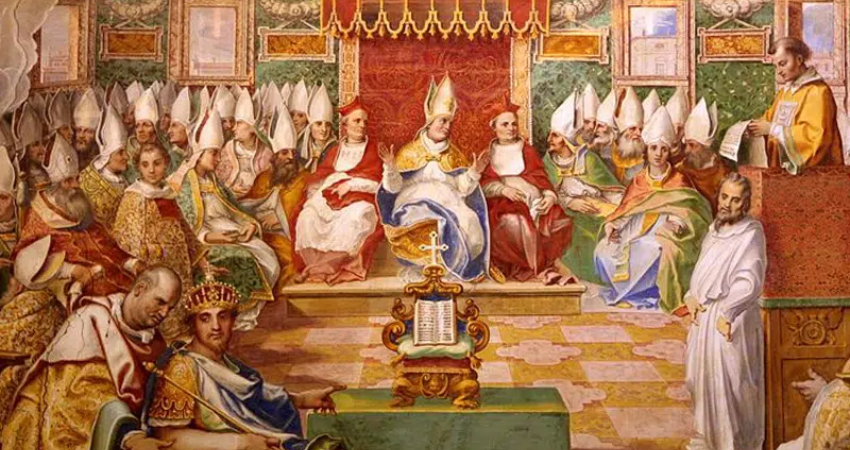The Council of Nicaea – Part 1
On the 20th May, 1700 years ago, approximately 300 bishops gathered in the imperial residence in Nicaea (now Iznik), a city to the east of Constantinople (now Istanbul). They had been summoned by the emperor, Constantine, to resolve a crisis that would shape the future of the Christian faith. How should the relationship of God ‘the Father’ and Jesus (the Son) be understood?
The origins of this growing crisis began in the North African city of Alexandria. After the persecutions during the rule of Diocletian, the city had been torn by division: should those who had fallen away from their faith under pressure be welcomed back into ministry – or not? The struggle to resolve this issue was made more difficult by a religious disagreement that escalated. A rather tall church leader, Arius (originally from Libya), criticised a sermon given by the bishop, Alexander. Arius believed the bishop had been ‘careless’ in how he spoke of the way the Father was similar to the Son. Arius felt the bishop had gone too far and weakened the uniqueness of the Father.
Eventually, Arius wrote a belief statement where he made a clear difference between the Father who was ‘eternal’, ‘alone without beginning, … alone and immortal’. He claimed that the Son (Jesus) was not eternally existing with the Father; in fact, he said, ‘there was once when the Son was not’. This view seemed to suggest that the Son was a created being, first and foremost the perfect example for humanity – but this had serious consequences. If the Son was not one with the Father, not eternal, not divine, then how could Christ (as the Son) truly know God and bring salvation?
It is not easy to fully explain Arius’ ideas. Very little of his own writing has survived. Because of the decisions made at Nicaea, the emperor ordered his books to be burned and he was sent into exile. Sometime later he was allowed to return, only it seems for him to be murdered in the streets of Constantinople. Our understanding of him mostly comes from his opponents, especially the passionate Athanasius (one of the great thinkers of the time / ‘a pillar of the church’), who came up with the term ‘Arianism’ more than ten years after the Council. Whether Arius would have agreed with all the ideas linked to his name is uncertain.
The Council met for several weeks: most of the bishops were from the Eastern churches – that is, what we now call Egypt, Türkiye, Lebanon, Syria, Greece, and Armenia, among others. The bishop of Rome was represented by two assistants; there was a bishop from France but none from Germany or England. The debates were at times a little heated (including one punch-up, it seems). Many of the bishops had experienced persecution.
Eventually, the Council wrote the Nicene Creed. Sometimes today people say that by doing so, they created a set of official beliefs that might limit personal faith and become a test of what is considered correct belief. But we need to see the bigger picture. Until the time of Constantine, the church had been a small group and often faced persecution. To express their beliefs and practices, they relied heavily on the quality and meaning of their worship and on the teaching of new members. Baptism required three years of preparation. They also had to answer to critics of their faith and had to explain who they were, who they followed, and why. It became a tradition for bishops to create local belief summaries, or rules of faith, to help with teaching and worship. One of the key questions was the relationship between the Father and the Son.
The Council decided that the Father and Son were of ‘one substance’. But the work of Nicaea wasn’t finished yet. Where did the Holy Spirit fit into the Christian understanding of God and God’s purpose to save? That question wasn’t settled – ‘one substance’ and ‘three persons’ – until nearly 60 years later at a Council held in Constantinople in 381. The years between 325 and 381 were full of twists and turns before the Nicene view was fully accepted.
Is it important? What we see here is the beginning of the Christian understanding of the Trinity. In recent decades we’ve come to see how deeply our view of God affects our life together and how we care for the world. In this Creed there’s a real effort to respond to what the Bible says about the Father, Son, and Spirit. The Creed was written in Greek and used philosophical ideas that don’t always translate well into our time – but Nicaea confirmed that Christ / the Son is truly God.
The questions behind Nicaea are still with us as we try to answer Jesus’ own question, ‘Who do you say that I am?’. These ideas show up in our worship and even in how our hymn books are arranged. The decisions made at the Councils of Nicaea and Constantinople can help us think about our worship – especially when one or more of the three ‘persons’ is never mentioned. That’s a sign that something is missing.
These Councils are an important part of our shared Christian history. But there’s still one big issue to explore: what happens when a Council is called by an emperor like Constantine?
Assoc. Prof. Clive Pearson is a Session Lecturer at United Theological College







1 thought on “How a 4th-century Theological Debate Helped Shape the Faith we Still Confess Today”
I found this piece of History very interesting. Always to look a bit further to encourage your growth with our Christian faith